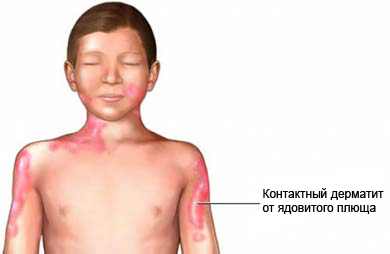Contact type allergy
Description of allergic contact dermatitis
Poison ivy, poison oak and poison sumac - are plants, in contact with which there is a rash, contact dermatitis. Red, unpleasant and itchy rash It manifested in the form of strips or blisters swollen spots (krapivnicы). This is the most common skin disease, which arises in contact with plants.

Causes allergic contact dermatitis
Rash occurs by contact with oil, which comprises ivy, oak and sumac. This oil is present in all parts of the plant: in leaves, branches, Flourish, fruits and roots. Oil is an allergen, so rash - an allergic reaction. Indirect contact with this substance can also cause rash. Such contact may occur, if a person touches the clothes, animal hair, sports equipment, garden tools or other objects, Plants that were near.
Risk factors of allergic contact dermatitis
Factors, which increase the likelihood of developing allergic contact dermatitis:
- Work or leisure in the area, where these plants grow in the spring, summer and fall;
- Contact with pets or animals, that come in contact with these plants;
- Contact with clothing or, are in contact with these plants;
- Exposure to smoke from these plants, when combustion.
Symptoms of allergic contact dermatitis
The main symptoms of the rash is:
- Itchy skin at the point of contact with the plant.
- Red bars or reddening of the contact.
- Small blisters or swelling (hives).
- Blisters, liquid containing.
Rash, usually, manifested through 8-48 hours after contact with the plant. But it can also appear through 5 hours or 15 days. Usually, if the allergy is shown for the first time, rash appears within a week. It appears in the new location in a few days, but there, where there was a contact with the plant.
The rash is not contagious. It is impossible to pass after its manifestations, even when in contact with blisters, because the oil has soaked or washed off the skin. It could seem, rash that spreads, but it can occur with early contact or contact with objects, which may contain oil.
The more oil fell on the skin, the greater the skin reaction. Sharp response, which appear on a small amount of oil, may be in humans, which are very sensitive to this allergen. Serious symptoms may include:
- Swelling of the face, mouth, Neck, genitals and eyelids.
- A large number of blisters, from which the liquid is released.
If treatment is not available, rash lasts from 10 days to three weeks. But people, are very susceptible to oil, the rash can stay for six weeks.
Diagnosis of allergic contact dermatitis
Diagnosis rash, usually, carried out at a physical examination. A doctor examines a rash and wondered about possible contact with the plant, its duration. If you are not sure whether, that the patient has had contact with the plant, nebhodimo learn about recent activities, work and hobbies.
Treatment of allergic contact dermatitis
After contact with the plants-allergens need to wash the body and the point of contact with soap and water. You can also use a special skin cleanser from oils. This will reduce the probability of occurrence of skin rash by more than 50%.
Treatment of scars
If the rash to appear, the itching and blisters usually disappear after 7-14 days without treatment. To reduce discomfort recommended treatment, including:
- Cool compresses with water or whole milk;
- Oral antihistamines;
- Medicines, otpuskaemыe without prescription:
- Creams of sunburn;
- Zinc ointment, or baking soda (to burst the blisters to dry);
- A solution of aluminum acetate (brown solution).
Steroids:
- Creams containing cortisone – They can relieve symptoms and may also shorten the duration of the rash;
- Oral corticosteroids – They may be prescribed in severe cases.
Preventing the rash from poison ivy, poison oak or sumac
To prevent a rash from poison ivy, oak or sumac is necessary:
- Learn how plants look, and avoid any contact with them;
- Never burn these plants;
- In wooded areas wear, which covers as much of the skin;
- Bathe pets in soapy water, if they come into contact with one of the plant;
- Wash clothing or objects, that, perhaps, We come into contact with these plants.
